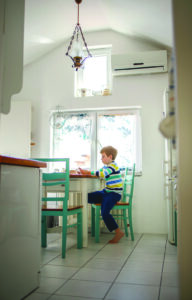Long before last Spring’s school closings and shelter in place quarantine, Easton-based Decorating Den interior designer Rayona Bennett and her husband, who both work from home, had faced the challenges arising from juggling limited space with multiple professional and family pursuits.

The good old kitchen table, once the nightly homework standby space, is now in demand for daily learning activities requiring durable flat writing support and spread-out space for projects.
Now she helps clients cope with the need to repurpose living quarters into effective homeschooling areas while maintaining viable home office set ups, not to mention sanity.
Students, parents and teachers have settled into a virtual learning routine by now, getting a sense of what has worked and not worked. Just like this year has taught us to expect change and make the best of it, households will likely continue to adjust.
The baseline requirement to making it all work is good Internet, Bennett advised. From there, the basics to cover include sound cancelling, privacy, laptop setup and flat writing space, comfortable seating, and decent lighting.
“But also crucial to the mix is the need for designated space to leave school and work behind and just be ‘at home,’” Bennett added.
The good news is that people have been finding creative ways and affordable means to effectively repurpose available space.
“Even a generous sized end table be used to set up a computer,” Bennett mentioned. “Oversized nightstands and vanities can do double duty as desks.”
Nooks can be carved out of corners of living rooms and dens; sometimes just a favorite chair with a flat table nearby can supply a workable makeshift desk.
The good old kitchen table, once the nightly homework standby space, is now in demand for daily learning activities requiring durable flat writing support and spread out space for projects.
Some families already see the potential need to invest in a new kitchen table, once this period of intensive use has passed, she reported.
Easily added items like portable table trays and quickly installed wall shelves help augment and organize shared areas. But Bennett cautioned that these new necessities are becoming harder to find as demand grows.
And for any extra home furnishings required or desired, its reassuring to learn that the furniture business itself is booming. But supply chain issues can impact and delay orders, she added, though not critically at this point.
Educational enterprises already attuned to distance learning during the pre-virus era have a storehouse of helpful tips on their websites and social media pages for parents now needing to adapt, among them, ACS International Schools (https://acs-schools.com/parents-guide-distance-learning, and Waterford.org (https://www.waterford.org/resources/how-to-create-an-at-home-learning-space/).
Most agree that the framework of following a schedule and focusing on the individual child while encouraging their input is the best recipe for success.
The Khan Academy (khanacademy.org) offers “Seven tips for setting up a productive learning space at home.”
First, location, location, location, depending on your child’s individual study style. Do they do best with quiet or background sound? But even for the noise lovers, keep phone, television, and social media access off limits, and use background music to fill the sound void.
Find the sweet spot between comfy and “too” cozy. Supportive chairs, yes, beds, maybe not. Good lighting, whether natural or lamp sourced, is crucial. (One parent used mirrors to enhance brightness.)
Set up a stocked supplies container within easy reach of the work area and use positive rewards to encourage tidiness.
Several sites also mentioned having kids repurpose and customize empty oatmeal containers and packaging.
Hanging an inspirational poster and personal artwork add inspiration and boost motivation during the learning day.
If family size and home space allow, maintain the space as a stand-alone school time mini environment.
For multi-student situations, a space schedule can be set up using portable supply containers such as boxes, backpacks, and rolling carts.
On Facebook, postings from parents and teachers (who are often parents) with the hashtag #distancelearning brings up a veritable wellspring of homespun and home tested fixes.
One teaching professional parenting several distance learning kids at home crafted study space separators using items like folding display boards used for science fairs, using stick on hooks to hang personalized supply baskets, folders, and other necessities.
Upon sharing the pictures on her Facebook page for family and friends, and being inundated with pleas for more ideas, she created and posted a YouTube video.
Not only kids, but parents, teachers, decorators, and architects are all taking notes and adapting during this second round of adapting for the home front for schooling needs.



